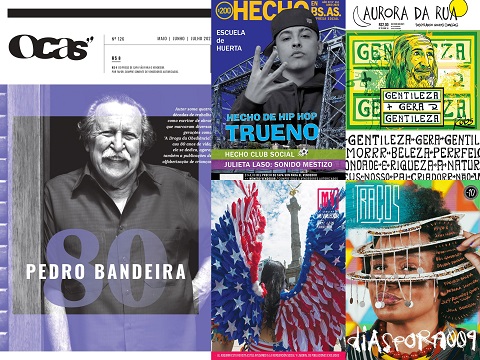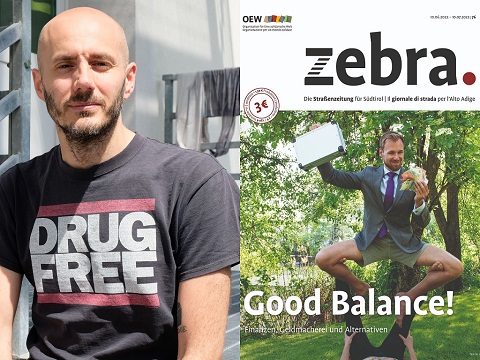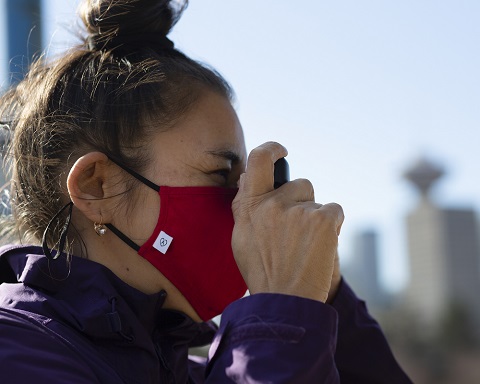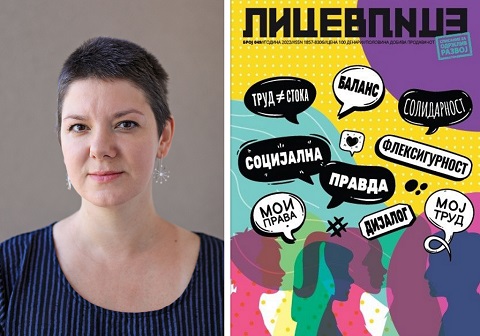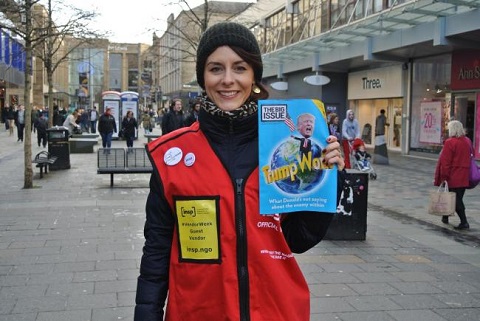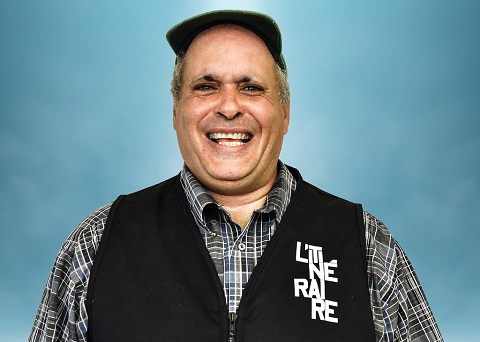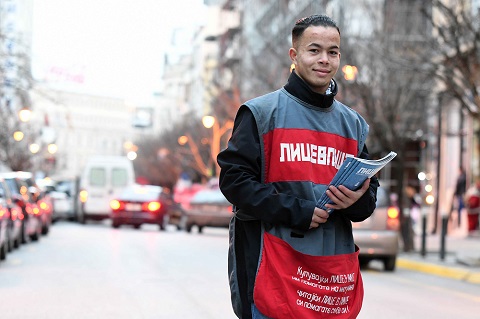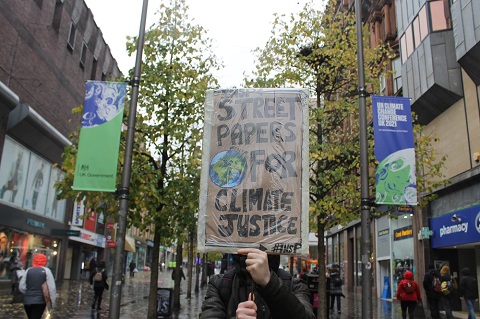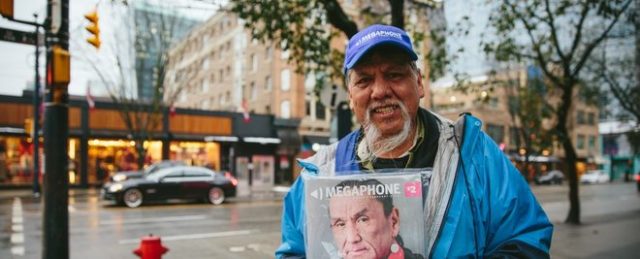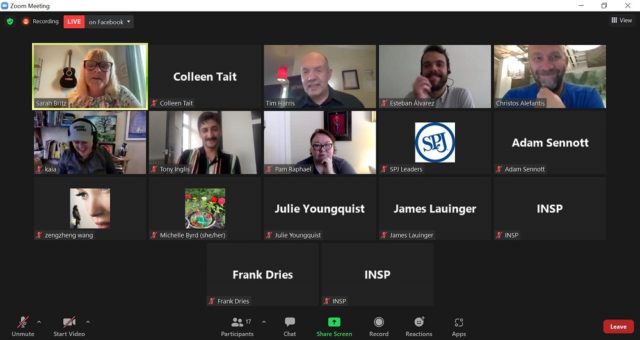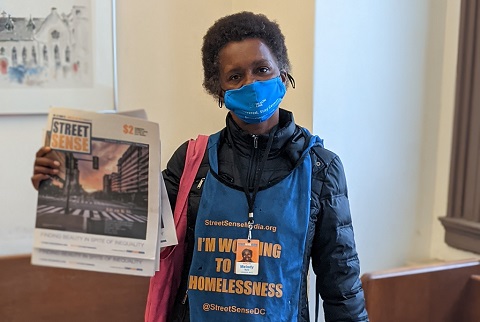By Paula Carlson, Megaphone
Ten years ago, Megaphone Magazine hit the streets for the first time.
From its first edition on 4 April 2008, Megaphone sought “to build livelihoods for socially excluded citizens and to break down stereotypes by empowering individuals and informing community.”
Today, hundreds of editions and thousands of stories later, Megaphone continues to amplify the voices of the people least likely to be heard in this burgeoning metropolis – those on low incomes, the homeless and folks struggling to find their way through myriad challenges, from addiction and mental illness, to violence and abuse.
It also provides vendors – the people who sell Megaphone – with a way to earn money and connect with the individuals and businesses in their communities, reducing the isolation that is often a painful part of poverty.
In addition to producing a now-monthly magazine that has recently expanded to Victoria, Megaphone runs the Hope in Shadows calendar project, which sees people living in poverty photographing scenes in their own neighbourhoods, and the Voices of the Street annual literary anthology, showcasing the writing talents of the Megaphone community.
This month, Megaphone reached out to talk to some key members of the publication – including vendors and past staff members – to get their take on what makes this organization so special.
Happy birthday, Megaphone! Here’s to many more years of making a difference.

When you make a connection, it’s a powerful charge
– Sean Condon, founder, editor, executive director: 2008-2016
I could say we knew what we were doing when Megaphone started 10 years ago. (We didn’t.) But an incredible group of vendors had laid the groundwork, so we had a good blueprint to work from.
It was run out of my apartment for the first year. Then we finally got a space on East Hastings – a unit so small we nicknamed it “the closet.” But folks in the Downtown Eastside are used to making do with what they have and can build community in the tiniest of spaces.
Megaphone showed me how small gestures make a huge difference. And while I expected to see that impact on the vendors, I was surprised customers experienced it, too. When you make a connection with someone, it’s a powerful charge.
The most frustrating part of the job was the window into how cruel and unnecessary poverty is. It’s a systemic problem rooted in racism, classism, sexism and stigmatized health problems. It could be eradicated if we had the political will.
Megaphone’s vendors survive and thrive despite these barriers. They are strong, compassionate and resilient. Each has a unique set of skills. Like anyone else, they just need an opportunity to flourish.
My fondest memories at Megaphone are the times we spent laughing together – sharing jokes in that closet of an office. I can’t remember any of the jokes (they were pretty bad), but I know every vendor’s laugh.
It’s a great honour to be the founder of Megaphone, which through its vendors and customers creates significant personal and social change. Powerful things can happen with that kind of energy.
Seriously? Yes, and definitely no, at this organization
– Jessica Hannon, volunteer stamp-licker and vendor support, vendor coordinator, operations manager, executive director: 2011-present
At Megaphone, I’ve met kind, funny people who will humiliate themselves for the greater good. That is including a lip-synch battle at a 2013 fundraiser in which former editor Kevin Hollett finished his rendition of Miley Cyrus’ ‘Wrecking Ball’ with an epic – and splinter-filled – knee-slide.
Learning that we don’t need to take ourselves too seriously to do serious work has been a big part of my Megaphone education. Through this community, I’ve learned we do each other a disservice if we oversimplify our experiences of the world. I’ve learned we can be fierce and fumbling, that no person is defined only by their struggle, and that someone receiving help does not preclude them from extending help to others.
From starting out at Megaphone both terrified of public speaking and of asking for donations, my love for this organization has put all that to bed. I’ve been humbled by the persistence of vendors, who hear hundreds of “no” responses each day before they get a “yes.” Their ability to put themselves out there has taught me the least I can do is ask for support to make their jobs a little easier.
When I started, Megaphone was a dedicated ragtag group of volunteers, vendors, readers and donors. Today, Megaphone has become a bustling social enterprise, a respected voice in media and a thriving community based in compassion.
I would gladly knee-slide across a splinter-filled floor singing Happy Birthday to Megaphone (though I hope I don’t have to).
Such a thrill to be with Megaphone
– Craig Baron, Victoria vendor: 2009-present
Selling Megaphone Magazine has been so tremendous. It gives me a financial opportunity to be a little bit more independent and be able to still afford things like food.
I’ve also made friendships. People have gotten to know me through the years and they recognize me, and it’s such a thrill. A lot of the staff throughout the different stores all respond to me in a positive way.
I’ve woken up to bad moods and by the time I come home that night from selling, I’m such a changed person. I’m in a good mood all because of the people – all because of the customers. I’m struggling to be better and better every time I go out, all because of my customers.
At least I was right about one thing
– Kevin Hollett, writer, volunteer, editor, board member: 2008-2016
When I started volunteering for Megaphone 10 years ago, I foolishly thought it was solely a journalistic endeavour, a tool to tell important stories and create change. It turned out to be one of those rare occasions I was right — just not for the reasons I thought.
Not long after launching, we did a reader survey to find out why people purchased the magazine. Regardless of the differences in the respondents’ age, neighbourhood, or income, everyone bought Megaphone for one reason: to support the vendors. And not just any vendor. Their vendor.
The folks who sell Megaphone are some of the best and hardest-working people you’ll ever meet. Rain or shine, they’re out there working. And they’re creating change — through the stories they share and the connections they make. Vendors aren’t just earning an income, they are also changing people’s perceptions about poverty and the people who experience it.
I’m amazed by how Megaphone and its community of vendors, volunteers, staff and customers have made positive changes in their city. See? I told you I was right.
Came for the experience, stayed for the community
– Amy Juschka, intern, associate editor, managing editor, communications committee volunteer: 2007-2015
A key part of Megaphone’s mission is to give a voice to homeless and low-income people, which then-editor, Sean Condon, liked to achieve by assigning me “streeter” interviews. As a shy, young journalist, nothing terrified me more than walking the streets of the Downtown Eastside with my camera and voice recorder, bugging people for their opinions.
This shaped me as a person and a professional. Megaphone gave me so much more than the ability to approach strangers with absurd questions. My time there connected me to a community of like-minded people who care about making change.
Megaphone continues to bring so much to this city – an economic opportunity for vendors, diverse voices at a time of increasing media concentration, stories about important issues in our city, a community for those in need, and an awesome cause to give our money to. Thank you, Megaphone, for making our community better for everyone.
From no beer or bathrooms, to a journalistic force
– Katie Hyslop, volunteer, writer, facilitator, news editor: 2009-2016
When I first started at Megaphone and I suggested we order pizza or buy beer for the Megaphone copy editing party, I was laughed out of the office we were squatting in. Megaphone didn’t have the budget for such frivolities!
But soon Megaphone started coming up in the world: moving to the closet-sized office in the Downtown Eastside, where going to the bathroom meant pretending to shop at Army & Navy so they’d buzz you into their bathrooms; paying contributors; moving to a bigger, nicer office with our own bathrooms; developing swag for vendors; and hiring staff. We even started buying pizza and beer.
Megaphone provided me with so many firsts: First cover story in a magazine; first time writing an article featured in street papers across North America; first opportunity to help elevate voices of people who weren’t being listened to – people experiencing poverty, racism, abuse, homelessness and addiction.
I am so proud of my time at Megaphone and how the magazine continues to thrive.

A foundation of treasured friendships
– Jackie Wong, volunteer, writer, facilitator, former editor: 2010-present
Ten years ago this May, I moved to an apartment in the West End. On my walks home from work, I’d bump into Richard selling Megaphone at Davie and Cardero. We’d chat, and I’d buy a copy of a magazine I found so refreshing to read.
With the city on the verge of bringing in the 2010 Winter Olympics, a rash of “renovictions” taking place, and a homelessness crisis that became a feature of our current mayor’s inaugural campaign, it was an important time for writing about social change. Megaphone did so with heart and verve, and I became an avid reader who tracked author and photographer bylines.
For me and so many who have crossed its path over the years, Megaphone has been a vital link to meaningful work, a supportive community and the foundation of treasured friendships. Megaphone’s community of vendors, writers and staff are among the kindest, most courageous and most generous people I’ve met. I can’t wait to see what the next 10 years will bring.
So much more than a spreadsheet
– David Lee, board member: 2010-present
I had heard that Megaphone was a young and dynamic social enterprise supporting individuals facing the challenges of poverty and homelessness. After being introduced to the magazine, I was simply planning to help with putting together a business plan, complete with accompanying spreadsheets. Instead, what I got over the years was much more than a corporate experience.
I remember being teary-eyed hearing a vendor (Suzanne a.k.a. “the Indian Princess”) speak at the first Megaphone fundraising event I attended at Café Deux Soleils, saying how Megaphone changed her life. And hearing countless other stories directly from vendors and community writers at the annual Voices of the Street literary launch. And seeing Bob, a longtime vendor and fellow board member, be recognized and receive a standing ovation for his contribution in front of 100 people at the last fundraiser.
Megaphone has given me a firsthand experience on how giving people voice, one person at a time, and connecting them to a community can change lives.
Over the moon for Megaphone
– Stefania Seccia, editor: 2016-present
I first came across Megaphone when I was in college. The idea behind the social enterprise was incredibly inspiring – here was good journalism making waves on subject matter that needed better coverage.
When I graduated and had a story idea, I really wanted Megaphone to publish it. I researched my story and sent in a pitch about the impact the new Woodward’s would have on the Downtown Eastside. Not only did they publish my story, they made it the cover, and I continued to write for Megaphone off and on. Megaphone helped launch my career and that means everything to me.
Later, it was serendipitous when I was working at a Vancouver daily newspaper and was ready to leave. It was then that Megaphone posted for its managing editor position. Somehow, I got the job and I’m forever grateful.
I believe so strongly in the type of journalism we do at Megaphone. I feel so lucky to work for an organization that really cares about its vendors, staff, volunteers and community at large. I am grateful for having the opportunity to make a difference.
Everyone working towards a common goal
– Mario Bassette, Vancouver vendor: 2017-present
I was at a shelter in September (2017). I was in a place where I couldn’t get a job. I had two dogs. Megaphone allowed me to sell the papers with my dogs.
Doing Megaphone, it’s given me a purpose. It teaches me to be accountable. The training is very helpful. These are transferrable skills; you learn how to approach people. That’s priceless.
I meet new people I respect… a whole range of people and we all have one goal: to work and make Megaphone better. I’m in a much better place now.
Over the years: A Megaphone timeline
APRIL 2008 – Megaphone launches, with a revamping and renaming of the existing Street Corner newspaper, which has been the voice of the city’s homeless and low-income communities for the previous eight years.
With founder and editor-in-chief Sean Condon at the helm, Street Corner is renamed Megaphone, as it aims to “amplify the calls for change” on poverty so Vancouver’s most marginalized can be heard. Its mission statement: “Megaphone’s goal is to build livelihoods for socially excluded citizens and to break down stereotypes by empowering individuals and informing community.” Megaphone is published as a bi-weekly, 24-page newsprint publication. Vendors purchase each issue for 50 cents and then “sell the paper for whatever the buyer and seller consider fair.” The inaugural issue hits the streets on April 4, 2008.
JULY 2008 – Megaphone goes legit! On July 21, 2008, Vancouver City Council votes in favour of giving Street Corner Media Foundation, the non-profit organization that publishes Megaphone, a one-year soliciting for charity (vending) licence, meaning Megaphone vendors now have the legal right to sell the magazine on the streets of Vancouver. Until now, since 1992, Vancouver’s only street paper (first as Spare Change, then Street News/Street Corner, and then Megaphone) operated on public property without an official licence.
JUNE 2009 – With Condon still occupying the editor-in-chief’s chair, Amy Juschka takes on the managing editor’s role.
MARCH 2010 – He’s moving on up: Wanting to focus on growing Megaphone’s business and outreach side, Condon takes on an executive director role with the non-profit organization. Kevin Hollett becomes managing editor.
APRIL 2010 – Voices of the Street literary anthology publishes its first issue, featuring the work from writers whose voices aren’t often heard. The 68-page publication sells for $5 until 2017, when the price is raised to $10. Voices of the Street provides a platform not only for Megaphone vendors, but also writers who participate in creative writing workshops run by the magazine at several locations in Vancouver and Victoria.
OCTOBER 2010 – Vendors now purchase each issue of Megaphone or 75 cents and sell the paper for a suggested donation of $2. All money from the transaction continues to go into the pockets of the vendors.
AUGUST 2012 – Megaphone celebrates 20 years of Vancouver’s street paper scene with a special edition. A little history: The first issue of Spare Change, the city’s original street paper created by journalist Michael McCarthy, was published in August 1992 and sold by homeless and low-income vendors. It later became The Street (1997-2007). Meanwhile, a vendor launches Street Corner in 2000, which goes on to merge with The Street in 2007. Wanting to give homeless and low-income people in Vancouver a strong voice, Condon and a new group of volunteers, including founding designer Annette Hansen, change the format of the paper to a magazine and rename it Megaphone in 2008.
Throughout the changes, the street paper concept in Vancouver continues to make a splash that reverberates across the city with Megaphone. Why the staying power? A simple yet powerful goal: Giving homeless and low-income people an opportunity to earn an income through a publication that informs, entertains and inspires the general public about social issues and current events affecting their communities.
JUNE 2013 – The Hope in Shadows project marks its tenth year showcasing the photography skills of Downtown Eastsiders. Originally launched by the Pivot Legal Society in 2003 and now run by Megaphone, the annual calendar project sees hundreds of disposable cameras distributed to vendors who then go out and capture scenes of their communities. Winning photos are published in an annual calendar, released each October, which vendors purchase for $10 and sell for $20, keeping the profits. Much like a street paper, Hope in Shadows gives a voice and economic opportunity to marginalized residents.
MARCH 2014 – Writer, journalist and literary instructor Jackie Wong takes over the role of managing editor, becoming the magazine’s first staff editor (as opposed to volunteers).
MAY 2014 – Megaphone takes over the decade-old Street Newz in Victoria, with the first edition of Megaphone being sold in both cities rolling out on June 20, 2014. There continues to be a mix of stories in the magazine looking at the important social, civic and cultural issues going on in both cities.
OCTOBER 2014 – Megaphone changes to a monthly, 32-page format.
JANUARY 2016 – Seasoned journalist Stefania Seccia (The Tyee, Vancouver 24 hours, Metro and more) becomes managing editor of Megaphone.
SEPTEMBER 2016 – Jessica Hannon takes over as executive director of Megaphone, after five years of working her way through the roles of vendor support services, vendor coordinator and operations manager.
JUNE 2017 – The Hope in Shadows project expands to Victoria.
OCTOBER 2017 – Megaphone partners with the Overdose Prevention Society to create and launch the How to Save a Life series in neighbourhoods across the city. The event amplifies the voices of Downtown Eastside community members as they share what it’s been like to live through the overdose crisis. It also teaches people how to save lives using naloxone, an antidote that reverses the effects of opioid overdoses.
TODAY – With a monthly circulation of between 3,500-5,000, each issue of Megaphone is made possible with the spirited work of a talented team made up of writers, reporters, photographers, designers, coordinators, vendors, board members, an editor, executive director and countless friends of the magazine.
Megaphone continues its mission to create meaningful work for people experiencing poverty and homelessness. Vendors sell award-winning publications on the streets of Vancouver and Victoria, connecting the public to stories about their communities.
More than $100,000 goes into the pockets of vendors every year. There are more than 150 vendors in Vancouver and Victoria. Vendors sell roughly 10,000 calendars and 40,000 magazines every year.





